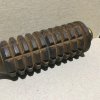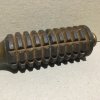After giving my nice acquired No:20 rifle Grenade a gentle clean with a moist cotton wool bud to clean the dust from the paint, i came across he remains of a black painted band around the middle of the segmented casting. Anyone know what this black band would denote, i did see on another post about 4 inch shells that it could be a TNT filling or for drill.
British Ordnance Collectors Network
You are using an out of date browser. It may not display this or other websites correctly.
You should upgrade or use an alternative browser.
You should upgrade or use an alternative browser.
Black band No:20 rifle grenade.
- Thread starter BMG50
- Start date
I have examined the black for any discolouration, a small scratch test would reveal and age process with paints, greens usually turn yellow with age especially in sun light plus the brown body paint is still the same original colour. Its black as black.
Well okay.
The attached is from a photo I took of what had once been the foremost collection of original British WWI grenades. Note the green bands on the three Nos 3 and 20 rifle grenades - they also have red "filled" bands around the body plugs.
Attachments
Nice photo but i cant see the green bands or am i colour blind. Funny how the brown body colour, reds and pinks dont change colour, i thought that the green of the time was the same as the WW2 Mills filling green. Was this WW1 green a dark green?
Last edited:
Black band could indicates other filling than common fillings ammonal/alumatol/amatol/Trotyl ?
Like Tonite, Cilferite or Abelite (explosives mentionned in good books for these grenades) ?
In British Service in WWI the only colour bands used to denote types of grenade HE bursting charges were pink and green.
Pink was used to denote military ammonal, the alumatols, tonite* and bellite*.
Green was used to denote the amatols (Abelite was simply 83/17 amatol), trotyl (TNT) and 20/80 baratol.
Cilferite C - no marking band but nature of explosive stencilled on box.
* tonite and bellite were used by the British for grenade bursting charges early in the war.
I tend to agree with Snufkin on this. All these paints were mixed by hand. There was a guide in the manufacturer's instructions but it was the sort of job given to a 13 year old lad so there's no guarantee the formula was adhered to, so it's more than likely that the green has darkened to black.
The original mixture was :-
Celestial Blue, dry 1 oz
Yellow Ochre 8 oz
Terebene 12 oz
I suspect that the mixtures varied greatly and as these paints were only to have life of perhaps a year at most, they were never tested to see if they stayed green for 100 years. Some Mills grenades have what looks like white band, but again this is Pink that has faded as the vermillion content decayed. All these paints were pure organic. Unlike today's paints and factories didn't buy paint off the shelf.
The original mixture was :-
Celestial Blue, dry 1 oz
Yellow Ochre 8 oz
Terebene 12 oz
I suspect that the mixtures varied greatly and as these paints were only to have life of perhaps a year at most, they were never tested to see if they stayed green for 100 years. Some Mills grenades have what looks like white band, but again this is Pink that has faded as the vermillion content decayed. All these paints were pure organic. Unlike today's paints and factories didn't buy paint off the shelf.


